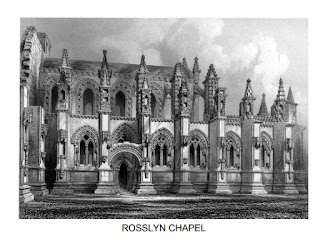Annie Wilson & Rosslyn Chapel
The foundation of Rosslyn Chapel, known as 'The Chapel amidst the Woods', a few miles south of Edinburgh, Scotland was laid in 1446. Its founder, William St Clair, Earl of Caithness and of Orkney, brought the finest workmen from the Continent to work alongside skilled Scottish craftsmen on the construction of the Chapel.The Chapel is famed for the profusion of elaborate and luxuriant sculptural stone carving that covers and encrusts almost every part of the building's interior. It has been described as 'one of those architectural wonders whose intricate beauties and peculiarities extort our admiration while they baffle description'. The unique and exuberant stone carving has been compared with exotic cake icing and makes the Chapel a pioneering building in the lavish use of ornament.
Most celebrated and outstanding amongst the architectural features is the exquisite workmanship of the Prentice Pillar, one of the internal columns, which is carved with rich foliage designs that spiral round the column. The quality and beauty of the Pillar's decoration is such that it has developed a tradition all of its own. This legend relates the story of the master mason at Rosslyn who went to Italy to study the original for the proposed design. While he was absent his apprentice, having dreamed that he had finished the Pillar, carried out the final carving work. On his return, the master mason was so enraged by a fit of envy that he killed the apprentice.
This well known legend is almost certainly apocryphal, as similar stories are told about a number of other churches. In Lincoln Cathedral, for example, there is a fine rose window that was, according to the story, fabricated by an apprentice in the absence of his master, who, humiliated at being so outdone, killed himself. Also, in Rouen Cathedral, there are two stained glass windows, one of which has a much more special character and beauty. The legend here is that the master architect and his pupil contested which would plan the finest window. Everybody agreed that the pupil's window was the best and the mortified architect revenged himself by killing the pupil.
The Prentice Pillar legend seems to be of fairly recent vintage, in terms of the age of the Chapel, and one of the main perpetrators of the story is thought to have been Annie Wilson, a 'venerable crone', who was the official guide at the Chapel for almost 50 years in the latter part of the 18th century and early 19th century. Annie provided her own homespun version of the history and architecture of the Chapel for the numerous visitors to Rosslyn. The commentary to her tour was always delivered in a monotonous voice and without pauses. Visitors soon discovered that it was unwise to interrupt her with a question as she would simply scowl at them and recommence her singsong recital from the beginning, it being impossible for her to resume the broken thread of her speech Annie's strong point was the Prentice Pillar and her description of it went like this: 'there ye see it with the lace bands winding sae beautifully roond aboot it. The maister had gane away to Rome to get a plan for it, and while he was away his 'prentice made a plan himself and finished it. And when the maister came back and fand the pillar finished, he was sae enraged that he took a hammer and killed the 'prentice. There you see the prentice's face up there in the corner, wi a red gash in the brow, and his mother greetin' for him in the corner opposite. And there, in another corner is the maister, as he lookit just before he was hanged; its him wi' a kind o' ruff roond his neck.'
The post of guide at Rosslyn Chapel was traditionally assigned to the proprietor of the inn that was adjacent to the Chapel and Annie was the wife of Daniel Wilson the landlord at the time. In her dual roles as innkeeper and guide, Annie met many of the celebrities of the age who visited the Chapel and partook of the hospitality at the inn. These included: Dr Samuel Johnson and James Boswell, Alexander Nasymth, Dorothy Wordsworth, Sir Walter Scott and Burns. It seems that Burns was so impressed by the hospitality at the inn that he rewarded Annie with a couple of verses scratched on a pewter plate:
My Blessings on you sonsie wife!
I ne'er was here before;
You've gi'en us walth for horn and Knife,
Nae heart could wish for more.
Heaven keep you free from care and strife,
Til far ayont fourscore;
And while I toddle on through life,
I'll ne'er gang by your door.
It would, therefore, seem that Annie Wilson was perhaps more accomplished in the kitchen than
she was a reliable and expert guide to the historical and architectural merits of Rosslyn Chapel.







Comments
Post a Comment